2.2: Indigenous Eastern North America- Forging a Middle Ground
- Page ID
- 231686
\( \newcommand{\vecs}[1]{\overset { \scriptstyle \rightharpoonup} {\mathbf{#1}} } \)
\( \newcommand{\vecd}[1]{\overset{-\!-\!\rightharpoonup}{\vphantom{a}\smash {#1}}} \)
\( \newcommand{\id}{\mathrm{id}}\) \( \newcommand{\Span}{\mathrm{span}}\)
( \newcommand{\kernel}{\mathrm{null}\,}\) \( \newcommand{\range}{\mathrm{range}\,}\)
\( \newcommand{\RealPart}{\mathrm{Re}}\) \( \newcommand{\ImaginaryPart}{\mathrm{Im}}\)
\( \newcommand{\Argument}{\mathrm{Arg}}\) \( \newcommand{\norm}[1]{\| #1 \|}\)
\( \newcommand{\inner}[2]{\langle #1, #2 \rangle}\)
\( \newcommand{\Span}{\mathrm{span}}\)
\( \newcommand{\id}{\mathrm{id}}\)
\( \newcommand{\Span}{\mathrm{span}}\)
\( \newcommand{\kernel}{\mathrm{null}\,}\)
\( \newcommand{\range}{\mathrm{range}\,}\)
\( \newcommand{\RealPart}{\mathrm{Re}}\)
\( \newcommand{\ImaginaryPart}{\mathrm{Im}}\)
\( \newcommand{\Argument}{\mathrm{Arg}}\)
\( \newcommand{\norm}[1]{\| #1 \|}\)
\( \newcommand{\inner}[2]{\langle #1, #2 \rangle}\)
\( \newcommand{\Span}{\mathrm{span}}\) \( \newcommand{\AA}{\unicode[.8,0]{x212B}}\)
\( \newcommand{\vectorA}[1]{\vec{#1}} % arrow\)
\( \newcommand{\vectorAt}[1]{\vec{\text{#1}}} % arrow\)
\( \newcommand{\vectorB}[1]{\overset { \scriptstyle \rightharpoonup} {\mathbf{#1}} } \)
\( \newcommand{\vectorC}[1]{\textbf{#1}} \)
\( \newcommand{\vectorD}[1]{\overrightarrow{#1}} \)
\( \newcommand{\vectorDt}[1]{\overrightarrow{\text{#1}}} \)
\( \newcommand{\vectE}[1]{\overset{-\!-\!\rightharpoonup}{\vphantom{a}\smash{\mathbf {#1}}}} \)
\( \newcommand{\vecs}[1]{\overset { \scriptstyle \rightharpoonup} {\mathbf{#1}} } \)
\( \newcommand{\vecd}[1]{\overset{-\!-\!\rightharpoonup}{\vphantom{a}\smash {#1}}} \)
\(\newcommand{\avec}{\mathbf a}\) \(\newcommand{\bvec}{\mathbf b}\) \(\newcommand{\cvec}{\mathbf c}\) \(\newcommand{\dvec}{\mathbf d}\) \(\newcommand{\dtil}{\widetilde{\mathbf d}}\) \(\newcommand{\evec}{\mathbf e}\) \(\newcommand{\fvec}{\mathbf f}\) \(\newcommand{\nvec}{\mathbf n}\) \(\newcommand{\pvec}{\mathbf p}\) \(\newcommand{\qvec}{\mathbf q}\) \(\newcommand{\svec}{\mathbf s}\) \(\newcommand{\tvec}{\mathbf t}\) \(\newcommand{\uvec}{\mathbf u}\) \(\newcommand{\vvec}{\mathbf v}\) \(\newcommand{\wvec}{\mathbf w}\) \(\newcommand{\xvec}{\mathbf x}\) \(\newcommand{\yvec}{\mathbf y}\) \(\newcommand{\zvec}{\mathbf z}\) \(\newcommand{\rvec}{\mathbf r}\) \(\newcommand{\mvec}{\mathbf m}\) \(\newcommand{\zerovec}{\mathbf 0}\) \(\newcommand{\onevec}{\mathbf 1}\) \(\newcommand{\real}{\mathbb R}\) \(\newcommand{\twovec}[2]{\left[\begin{array}{r}#1 \\ #2 \end{array}\right]}\) \(\newcommand{\ctwovec}[2]{\left[\begin{array}{c}#1 \\ #2 \end{array}\right]}\) \(\newcommand{\threevec}[3]{\left[\begin{array}{r}#1 \\ #2 \\ #3 \end{array}\right]}\) \(\newcommand{\cthreevec}[3]{\left[\begin{array}{c}#1 \\ #2 \\ #3 \end{array}\right]}\) \(\newcommand{\fourvec}[4]{\left[\begin{array}{r}#1 \\ #2 \\ #3 \\ #4 \end{array}\right]}\) \(\newcommand{\cfourvec}[4]{\left[\begin{array}{c}#1 \\ #2 \\ #3 \\ #4 \end{array}\right]}\) \(\newcommand{\fivevec}[5]{\left[\begin{array}{r}#1 \\ #2 \\ #3 \\ #4 \\ #5 \\ \end{array}\right]}\) \(\newcommand{\cfivevec}[5]{\left[\begin{array}{c}#1 \\ #2 \\ #3 \\ #4 \\ #5 \\ \end{array}\right]}\) \(\newcommand{\mattwo}[4]{\left[\begin{array}{rr}#1 \amp #2 \\ #3 \amp #4 \\ \end{array}\right]}\) \(\newcommand{\laspan}[1]{\text{Span}\{#1\}}\) \(\newcommand{\bcal}{\cal B}\) \(\newcommand{\ccal}{\cal C}\) \(\newcommand{\scal}{\cal S}\) \(\newcommand{\wcal}{\cal W}\) \(\newcommand{\ecal}{\cal E}\) \(\newcommand{\coords}[2]{\left\{#1\right\}_{#2}}\) \(\newcommand{\gray}[1]{\color{gray}{#1}}\) \(\newcommand{\lgray}[1]{\color{lightgray}{#1}}\) \(\newcommand{\rank}{\operatorname{rank}}\) \(\newcommand{\row}{\text{Row}}\) \(\newcommand{\col}{\text{Col}}\) \(\renewcommand{\row}{\text{Row}}\) \(\newcommand{\nul}{\text{Nul}}\) \(\newcommand{\var}{\text{Var}}\) \(\newcommand{\corr}{\text{corr}}\) \(\newcommand{\len}[1]{\left|#1\right|}\) \(\newcommand{\bbar}{\overline{\bvec}}\) \(\newcommand{\bhat}{\widehat{\bvec}}\) \(\newcommand{\bperp}{\bvec^\perp}\) \(\newcommand{\xhat}{\widehat{\xvec}}\) \(\newcommand{\vhat}{\widehat{\vvec}}\) \(\newcommand{\uhat}{\widehat{\uvec}}\) \(\newcommand{\what}{\widehat{\wvec}}\) \(\newcommand{\Sighat}{\widehat{\Sigma}}\) \(\newcommand{\lt}{<}\) \(\newcommand{\gt}{>}\) \(\newcommand{\amp}{&}\) \(\definecolor{fillinmathshade}{gray}{0.9}\)The historian Richard White's concept of the "middle ground" helps one to understand moments when diverse peoples come into contact and create new systems of meaning and exchange. The middle ground is a place where worlds overlap, yet leave a space in which cultures can adapt to new conditions. 2 Despite the unequal power between themselves and the colonists, indigenous North American societies were able, over time, to adapt to the new presence in their land, finding some convergences between their artistic practices and those of the Europeans. The term used to define this form of cultural encounter is syncretism-the melding of two or more different belief systems, artistic styles, or cultural practices to form a third, distinctly different one.
Although many indigenous societies had been dislocated from their ancestral homelands as a result of white settlement, epidemic, forced relocation, intertribal raiding, warfare, and shifting ethnic alliances, they were nevertheless often able to devise a culture of the middle ground. The crucial factor permitting this was that Natives and Europeans met in partnerships from which each benefited, based on trade. Natives retained aspects of their cultural autonomy as they hunted and trapped America's abundant wildlife to supply an international market. The pelts and hides were sent to Europe; in exchange, cloth, iron and silver, and glass beads made their way across the ocean to North America. The indigenous artistic repertoire expanded to incorporate these trade goods. Although their cultures were changing so rapidly as to be threatened with virtual extinction, Native people acquired and assimilated new materials and motifs, while trying to exploit new opportunities for economic and artistic enrichment. The visual culture of the middle ground was hybrid and inventive, resilient in the face of foreign occupation.
Early twentieth-century anthropological schemes sought to classify American Indian art objects in terms of individual tribal styles with recognizable differences. But in the eastern half of the continent, in the centuries from 1600 to 1900, this sort of classification is not useful. In the middle ground of the Great Lakes, for example, tribal affiliation was less important than village or clan affiliation. Villages often included members of several different tribes, drawn together because of the pressures caused by colonization. Cross-cultural bonds were established through gift giving, adoption, intermarriage, and ceremonies that transcended tribal affiliation, like the ritual smoking of tobacco and the exchange of wampum; see "The Repatriation of Wampum," page 39. All of this had ramifications for the visual arts, in which both cultural conflict and accommodation were played out.
New Materials and New Markets
Only a few artistic objects made by Native Americans have survived from before the mid-eighteenth century. Most were made of perishable materials such as wood, feather, skins, porcupine quills, and moose hair-items that deteriorate unless held under optimal conditions.
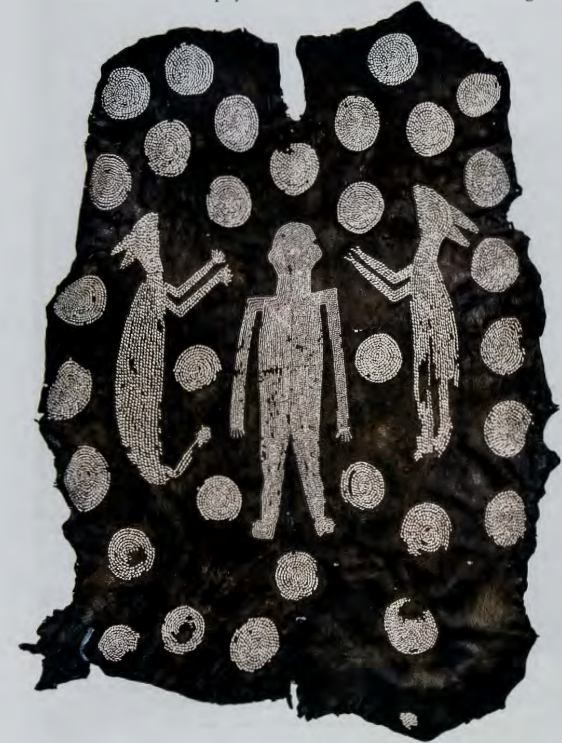
"POWHATAN'S MANTLE." One of the earliest items collected and preserved in a European museum is an object nicknamed "Powhatan's Mantle" (fig. 2.12). It is unclear whether this did, in fact, belong to Powhatan (1547-1618), the paramount chief of the Virginia Algonkians. Moreover, it is far too big to be a mantle or cloak (over 7 by 5 feet). Consisting of four deerskins sewn together, it is decorated with marginella shells. These are sewn to depict a frontal human figure flanked by two animals in a field of many circles. This may have been a valued object kept in a temple and used in ceremonies for hunting magic or other spiritual pursuits. It is a good example of an indigenous pictorial tradition that would soon be transformed by contact with European artistic conventions.
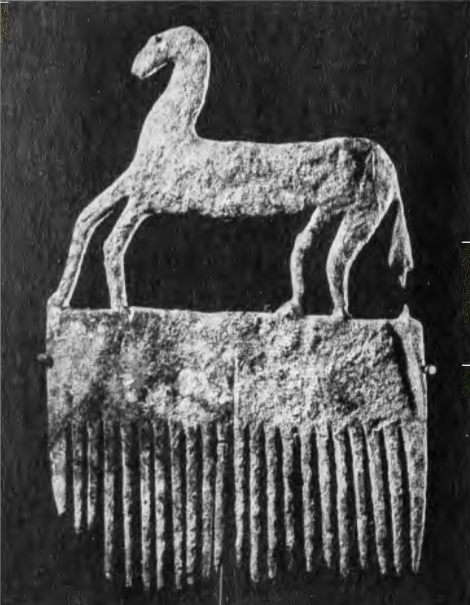
HORSE EFFIGY COMB. Native peoples often showed a readiness to treat new subject matter in familiar materials. As we have seen, they had a long tradition of representing animals in their art, and this continued after their contact with Europeans. In some cases they depicted the clan animals of particular families; for example, among the Iroquois, during the sixteenth and seventeenth centuries, it was the custom to add handles carved as wolves or bears- Iroquois clan animals- to the combs they carved from bone, wood, and moose antler. When the horse made its first appearance in western New York (then a colony) in 1677, it must have caused a sensation among the Iroquois, whose belief system included great respect for the power of animals and who naturally wished to incorporate this majestic animal into their imagery. This comb (fig. 2.13) depicting a horse was excavated from an Iroquois site near Victor, New York, and can be dated to 1670-87. It records the appearance of a new subject in a traditional format.
WAR CLUB. The war club shown here (fig. 2.14) is a modification of an indigenous weapon-the wooden club-with some aspects of new weaponry included.
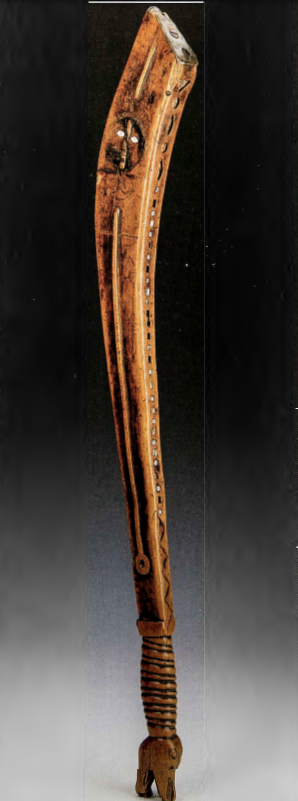
The artist has examined European sabers with some care: the rais.ed line that extends down the club mimics the raised strengthening rib of a European saber, while the handle mimics its wire-wrapped hilt. The club ends in a carving of a wolf's head. The edge of this wooden "saber" is inlaid with both local shell and European beads-this combination of materials and form suggesting that the maker sought to copy a new weapon in materials that he understood. By doing so, perhaps he hoped to draw spiritual and military power from sources both local and distant.

The small head with inset shell eyes incised on the club (fig. 2.15) may portray the object's owner. The head is abstract in its moonlike roundness, but the diagonal line bisecting the face and the three-pronged tattoo on the mouth surely denote an individual who would be recognizable to his peers, thus making it a portrait. Although a Native artist made this club for his own use, a white man acquired it in combat. A family tradition claims that Lieutenant John King of Northampton, Massachusetts got it in a 1676 battle; the club passed down through his family until the mid-twentieth century.
PIPE TOMAHAWK. In addition to serving as the spoils of warfare, objects moved across cultures through gift giving. Both the tomahawk and the pipe were indigenous items, used for warfare and ceremony. But in the world of the middle ground, these two items could merge into a curious hybrid: the pipe tomahawk was a decorative presentation piece, often made for cross-cultural gift giving.
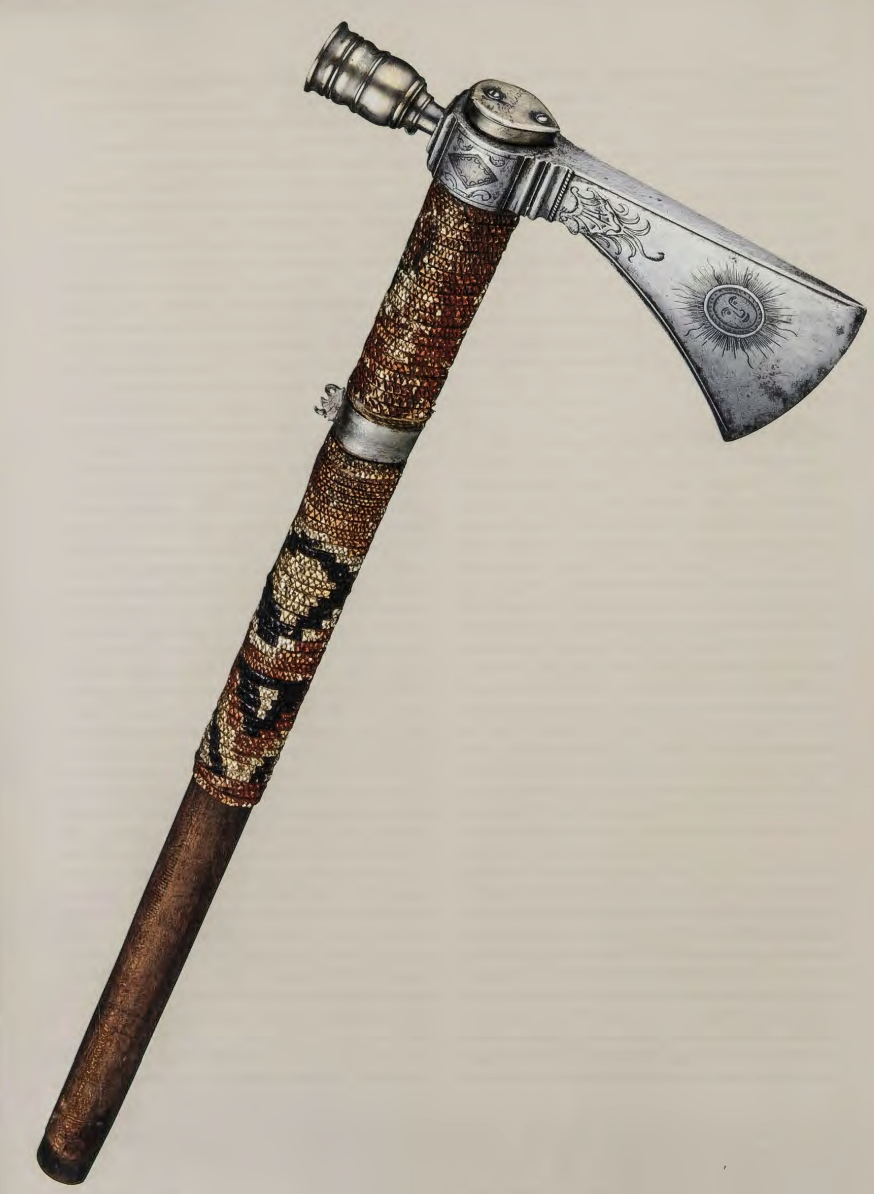
The one shown here (fig. 2.16) dating from just before the American Revolution, combines Native wrapped quillwork with European metalsmithing. The hatchet/ pipe bowl, made of pewter, is engraved with the names of the EuroAmerican gunsmith who forged it and the military man who owned it. A uniquely American form, the pipe tomahawk was intended to bridge the gap between cultures. It is an odd hybrid, for the pipe generally signifies peace, while the hatchet signifies warfare-is it an object that extends the possibility of both conflict and accommodation? Pipe tomahawks were sometimes used as diplomatic gifts, presented at the signing of peace treaties. The wooden shaft is covered with plaited quillwork, the artistry of a Native woman, so its manufacture crosses not only cultural boundaries but gender roles, too. Many such items still exist in British family homes, souvenirs brought home by ancestors who fought in wars in North America.
A PAIR OF CEREMONIAL POUCHES. Native women in different parts of North America used bird and porcupine quills (like those on the shaft of the pipe tomahawk) for artistic purposes, softening and dyeing them, and then using them to wrap or embroider items to decorative effect. A transformation of indigenous form and subject is illustrated in two ceremonial pouches from the Great Lakes region, which use quillwork to represent religious iconography.

On one side, the eighteenth-century Anishnabek tabbed bag (fig. 2.17) carries the image of a thunderbird (a powerful mythical denizen of the sky world), while on the other side two turtles (symbolic of the earthly world) float beneath the horizon. With its two-legged shape, the bag itself looks like an otter, and was used to hold ritual paraphernalia.

The wall pocket in figure 2.18 (a European form used as a holder for papers) employs the same pictographic strategy as the tabbed bag, yet the symbols extend across two cultures, Native and Christian, encompassing, in Ruth Phillips' s words, "a spectrum of representational possibilities that were exploited simultaneously." Turtles, again, ornament the bottom. Above, semi-abstract human figures-some arriving in a boat, some inside a church- occupy the middle ground. Crosses adorn the church and the flags. Here, Christian iconography' seems to be subsumed into an indigenous worldview, represented by the two floating forms of "turtle island" (as some Native groups conceptualize the earth). Such items were made for use both by Native practitioners of traditional religion and by Native converts to Christianity; some were sold to whites.
A PAINTED HIDE. When indigenous artistic traditions came into contact with European ones, changes also ensued in style. Native representations of people and animals were pictographic as well as semi-abstract, with animals often depicted in a geometric, simplified style, as in the turtles mentioned above. Yet sometimes vivid detail was rendered with great economy. Often, Native artists chose to adopt aspects of Euro-American painting- for example, by demarcating a ground line, or through some limited use of perspective or naturalistic detail. This meeting of indigenous and European modes of representation took place in different regions at different times. A hide painted by a Great Lakes man shows some of these changes (fig. 2.19).

Both in the Great Lakes region and on the Great Plains, hides were tanned and painted in a manner that reflected the animal form from which they came. Here, the frame for the picture is five sided and has a tail. Like the pipe tomahawk and the wall pocket described above, the scene seems to represent both conflict and accommodation. On one side of the hide, figures aim weapons at each other; on the other side, they join hands. At the bottom of the hide, the conical houses of indigenous Illinois people are contrasted with the French mission and trading post on the left. The writing on the hide (perhaps done by Jesuits at the mission) identifies particular villages and tribes. No historical records survive concerning the acquisition of this hide painting, which has long been in France. Its subject matter suggests that it is an intercultural record of an important alliance among the French, and the Algonkian and Quapaw Indians.
The middle ground of the sixteenth and seventeenth (and in some regions, the eighteenth) centuries was a space that emerged within a context of ongoing conflict and resistance, a space in which each party to the encounter gained something from the exchange or adaptation of forms and symbols. For Native people, this could occur by accommodating foreign elements within indigenous belief systems, ensuring continuity in the midst of enforced change. In other cases, the middle ground emerged during periods when Native people enjoyed relative sovereignty for example, when the Iroquois traded items as political equals with Europeans. (See also "The Repatriation of Wampum," p. 39.) As competition for land and resources raised the level of conflict, however, the middle ground proved all too fragile.
Wampum: A Contract in Shells
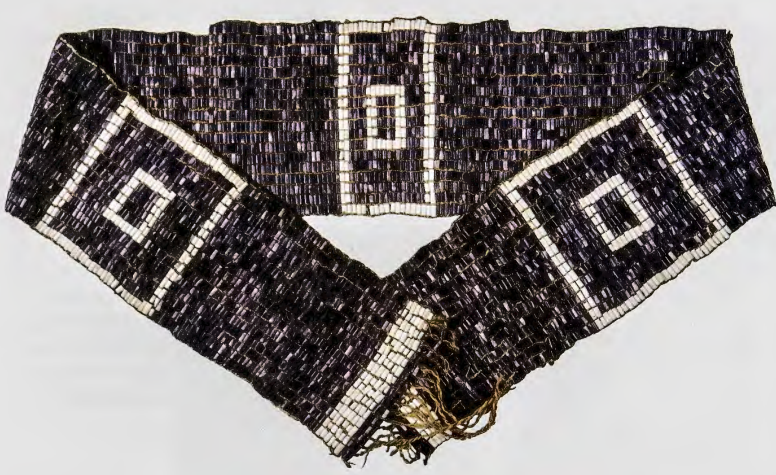
Wampum beads (from the Algonkian word wampomeag) were made from the dark purple shell of the quahog clam and the white shell of the whelk-and were worn and exchanged by indigenous peoples of the Northeast. During the seventeenth century they were also used as money by Dutch and British colonists when European coins were scarce. The Iroquois strung wampum beads onto belts, often in pictorial designs (fig. 2.20). An inland people, they did not manufacture the beads themselves, but obtained them through trade with coastal peoples and later through trade with the Dutch at Fort Orange (Albany, New York). Originating in the seventeenth century, wampum belts were made to commemorate important events within the Iroquois community, as well as treaties and legal transactions between the Iroquois and other ethnic groups. As part of the protocol of treaty-making, the Dutch and English quickly learned to use them as the Iroquois did: as both gifts and evidence of contractual arrangements. The images worked in beads were mnemonic devices, linked to a tradition of oratory by which history was handed down through the generations. The belt shown here is formed almost completely of purple quahog-shell beads, whose rich, dark texture is interrupted only by three double rectangles of white beads. Although the oral history that goes with this piece has been lost, it may commemorate an alliance among three groups, each represented by a set of white beads. Another belt, the Two-Row Wampum, uses two parallel rows of purple beads set on a field of white to symbolize the separate and equally sovereign paths of two great nations: the Iroquois Confederacy and the United States. From the perspective of U. S. history, one of the most famous pictorial belts is the George Washington Covenant Belt, made c. 1776, which is over 6 feet long and contains some ten thousand beads. Thirteen large human figures join hands with two smaller figures standing on either side of a house. The large figures have been interpreted as emblems of the founding colonies of the United States joined in an alliance of peace and friendship with the Mohawks and Senecas who, among the Iroquois Confederacy, are known as the Keepers of the Eastern and Western Doors (the territory of the Confederacy being visualized metaphorically as a house, with the Mohawks on the east side of what is now New York State and the Senecas on the west).
The Iroquois were not the only people to commemorate transactions in wampum. Some Huron and Abenaki belts with Latin inscriptions were sent in the seventeenth century as gifts from Catholic Indians and French Jesuit priests to Chartres Cathedral, in France, where they still remain. In the 1710 portrait of his visit to London (see fig. 2.22), a Mohawk man holds a wampum belt aloft. Wampum belts circulated among cultures, constituting a new form of communication across the gulf of divergent languages, histories, and representational forms.
The Repatriation of Wampum
"Repatriation," a term increasingly used in relation to Native American materials, means the return of objects of cultural significance to their original owners or makers. The repatriation of important Indian objects housed in museums has accelerated recently, due to the passing of the Native American Graves Protection and Repatriation Act of 1990. Somewhat earlier, the Iroquois were the first to urge that important objects of their cultural patrimony wampum belts-be returned to their nation, where an individual entitled "Keeper of the Wampum" is invested with the authority to guard and narrate the histories of these objects. Following laws passed in the 1970s and 1980s, many Iroquois wampum belts previously considered the property of museums, including the George Washington Covenant Belt, were returned to reservation authorities, both in New York State and in Ontario. George Abrams, an Iroquois scholar, has remarked that, to the Iroquois, "wampum was and is the manifestation of their sovereignty as distinct nations and as political equals among other nations."3 Though these wampum belts were made as objects of intercultural encounter, they reside today in the hands of their original makers, and are sometimes brought out in public to help narrate the history of the Iroquois Confederacy
"Fond of Finery": Portraiture and Self-Display
The Frenchman Pierre Pouchot, writing about his sojourn in eastern North America in the 1750s, recalled that Indians he encountered were "fond of finery." From ancient times, Native people had presented their bodies as canvases for self-decoration. Ochre clays were used to paint temporary designs on the skin, and carbonized materials were used for permanent tattoos. Indian people were pleased to trade for Chinese vermilion and European inks, which worked well for these purposes. The Indian figure in the foreground of Benjamin West's painting The Death of General Wolfe (see fig. 4.34) represents such tattoos in detail. That warrior has abstract tattoos on his limbs and face and a naturalistic serpent on his shoulder blade. The small pipe shown here (fig. 2.21) may have served as the model for his head: it sports the same triangular pendant earring and face painting design, and was originally in Benjamin West's own art collection.
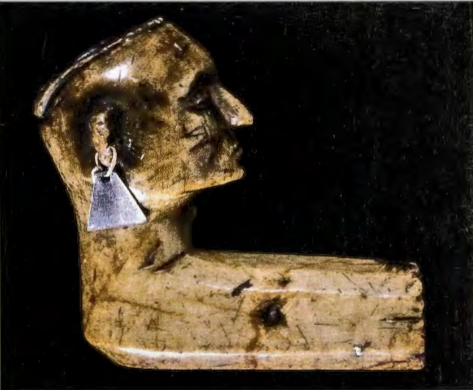
Both this small soapstone pipe bowl and the delicate face on the seventeenth-century Iroquois club discussed above (see detail in fig. 2.15) bring up the issue of portraiture in Native American art. Since tattoo and face paint designs were particular to the person, both images may depict actual individuals. Seldom in Native art before the twentieth century do we see portraiture that relies solely on physiognomy to identify an individual, as in European and Euro-American painting. Instead, distinctive tattoos (such as the lines, dots, and mouth tattoo on the face on the club), hairdos, and items of ceremonial regalia identify the individual. In eastern North America during the colonial period, an idiosyncratic and stylish wardrobe was a mark of distinction for warriors, prosperous Native women, and diplomats.
Indigenous dress drew upon materials from the plant and animal world: hides of deer, moose, caribou, and other animals; bird pelts and feathers; deer hooves and dew claws; porcupine and bird quills; whole shells and beads painstakingly worked from shells. Daily dress was relatively simple. Weather permitting, men often went naked, or nearly so. (Again, The Death of General Wolfe provides a realistic depiction.) Women may have worn simple deerskin dresses. Yet dress for important occasions was quite elaborate, as European travelers throughout eastern North America attest. For example, Bernard Romans, who traveled in Florida in the eighteenth century, described Native women dressed for dancing:
I observed the women dressed their legs in a kind of leather stockings, hung full of hoofs of the roe deer in form of bells, in so much as to make a sound exactly like that of castagnettes; I was very desirous of examining these stockings and had an opportunity of satisfying my curiosity on those of my land lady on her return home. I counted in one of her stockings four hundred and ninety three of these claws; there were nine of the women at the dance with this kind of ornament, so that allowing each of them to have had the same number of hoofs, and eight hoofs to a deer, there must have been killed eleven hundred and ten deer to furnish this small assembly of ladies with their ornaments, besides which, earrings, bracelets, &c. are by no means forgot; an instance of luxury in dress scarcely to be paralleled by our European ladies. 4
Such profligate use of deer hooves in indigenous dress was a secondary result of the extensive fur trade. Deer and other fur-bearing animals were being hunted by men, and the skins tanned by women as fodder for the European trade. In 1726, for example, an estimated fifty thousand deerskins a year were exported by the French from the region around New Orleans alone! 5 Europeans coveted these hides for use in clothing, having depleted their own local sources of game over many centuries of hunting and settlement.
Most eighteenth-century travelers noticed that Native finery made from the materials of the local, natural world ( or items gained from long-distance trade with other Native groups) was rapidly being replaced by trade goods. Native people quickly adopted-and adapted-men's shirts, cloth by the yard, trade blankets, ribbons, thread, hats, silver ornaments, and glass beads to fashion new styles of clothing valued both by Indians and by some whites who lived and worked closely with them, such as fur traders and soldiers. As Native and whites alike grew more prosperous due to the fur trade, and as military men sought to demonstrate their familiarity with the new and diverse world of North America, practices of dress and self-adornment in the middle ground grew more hybrid and more inventive, as the following analysis of two sophisticated travelers reveals.
HENDRICK AND JOHN: TWO EIGHTEENTH-CENTURY GENTLEMEN AT THE BOUNDARIES OF CULTURES. Two portraits of high-ranking men, a Mohawk in European clothing and an Irishman in Native dress, illustrate what we mean by arts made at the boundaries of cultures. One, painted at the beginning of the eighteenth century, was among the first influential and widely distributed portraits of an Indian. The other, painted at the end of the century, was a private portrait for the home of an Irish lord who had served in the wars in America. Both paintings imply the existence, at the time, of patrons comfortable with the idea of cross-cultural movement. The work of trained European artists, both portraits suggest the possibility that in America-unlike Europe, with its rigid class system- a man could remake himself according to his ambition and talent.
In 1710, four headmen of the Mohawk nation ( one of the member nations of the Iroquois Confederacy) traveled from their home near Albany, New York, to England to petition Queen Anne to send them a British clergyman (whom they would prefer to the French Catholic Jesuits who had worked among the Iroquois). Their journey was well publicized, both in America and in England. As was customary in Indian diplomacy, many gifts were exchanged. The Mohawks gave the British monarch gifts of wampum and other finely crafted items made by Iroquois artists. Queen Anne, in turn, gave them a Bible, cash, fine textiles, and a set of silver religious items engraved with her coat of arms ( a gift still preserved today by the Iroquois as an heirloom). She outfitted them in fine clothing at her expense, and commissioned portraits of the four to be painted by the Dutch artist John Verelst. The "Four Indian Kings," as they came to be called, were the toast of British society. Other portraits were painted, too, and small, inexpensive engravings based upon these were widely circulated in the streets of London. Their speeches were printed in broadsides, and ballads were even composed about them.

The highest ranking among the four was Tee Yee Neen Ho Ga Row (c. 1680-1755), also known as Hendrick, the name under which he was baptized as a young man. Born a· Mahican, but adopted by the Mohawks as a child, he lived in Canajoharie village, in what is today central New York State. He rose to become one of the headmen, or "sachems," of his community (a rank that the British wildly exaggerated, calling him "Emperour [sic] of the Six Nations"). Set in an illusionistic landscape (fig. 2.22), he appears as a sophisticated statesman, dressed in gentlemen's shoes with silver buckles, dark hose, and a long black waistcoat over a white linen shirt. Atop this he wears a scarlet blanket, an item of trade that Indians rapidly adopted as their own. In his right hand he holds a wampum belt. Its pattern of repeated crosses is perhaps symbolic of the delegation's quest to ask the queen for a missionary from the Church of England. Behind Hendrick lurks a wolf, symbolizing Hendrick's membership in the Mohawk wolf clan. Cast down on the ground before him is a tomahawk. Hendrick does not hold a weapon, for he is a diplomat, as the wampum belt indicates. Adopted by the Mohawks, first converted by Catholics, preparing for conversion to the Anglican faith, and dressed in British finery accented with Native and European trade items, Hendrick is the very picture of the cosmopolitan, moving between disparate worlds.
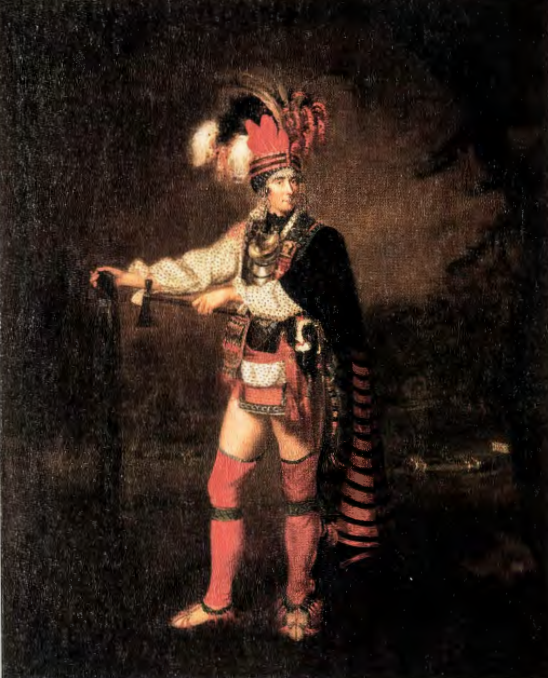
Some seventy years after Hendrick's portrait was painted, an Irish nobleman returning from America commissioned a portrait in which he, too, is dressed in the finery of another culture (fig. 2.23). Sir John Caldwell served as an officer in the British Army and was stationed at Fort Niagara and Fort Detroit. While in North America, he established good relations with the Ojibwa Indians, and was named a headman among them. Like Hendrick, John Caldwell holds a wampum belt in his outstretched right hand. The design worked in white on the purple belt is of a hatchet, like the one he holds in his left hand. At his waist is a brass-handled saber.
Caldwell wears deerskin moccasins, red cloth leggings held up with beaded garters, a short breechcloth, a printed calico shirt, and a dark blue and red cloak. Adorning his body are many items made and used by both Indians and whites throughout the Northeast in this era: a quilled leather pouch, a medicine bag made of a skunk skin, a quilled knife sheath, and much silver and brass jewelry. Just as his whole costume is a statement about intercultural commerce, so too is his headdress. It is composed of a quilled band, metal ornaments, and both local and exotic plumes, including ostrich feathers.
The cosmopolitan Hendrick and John remind us that negotiating multiple realms has been an integral part of Native-white interaction since the first European contact.


